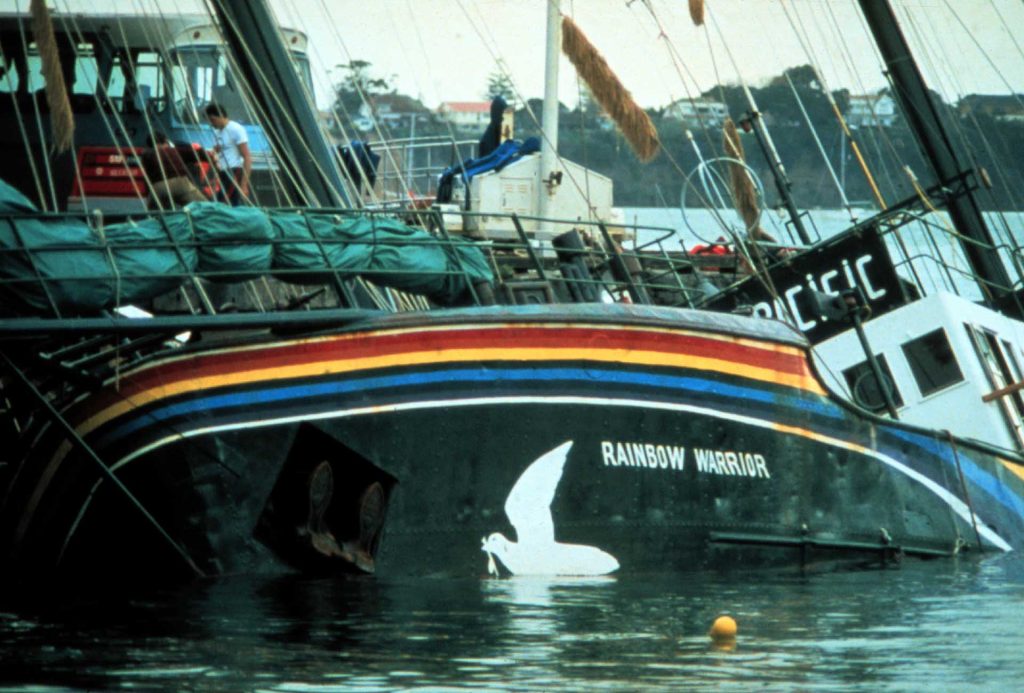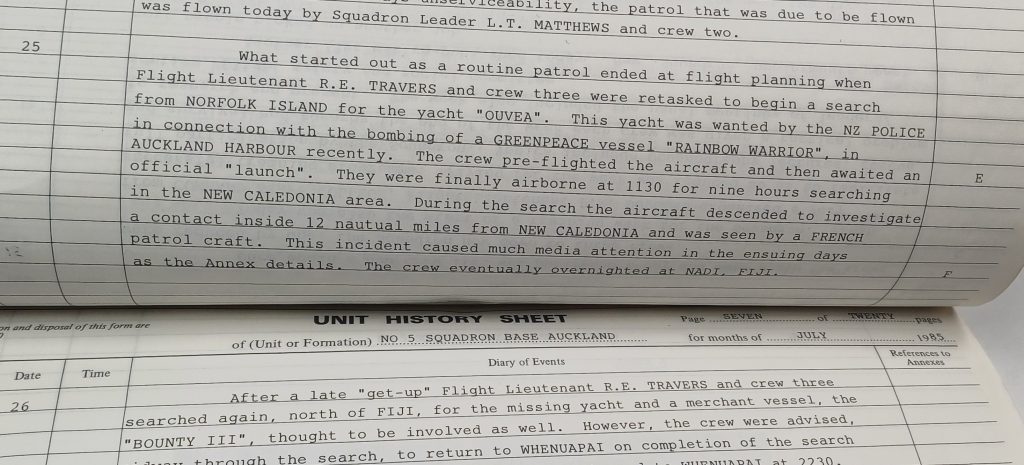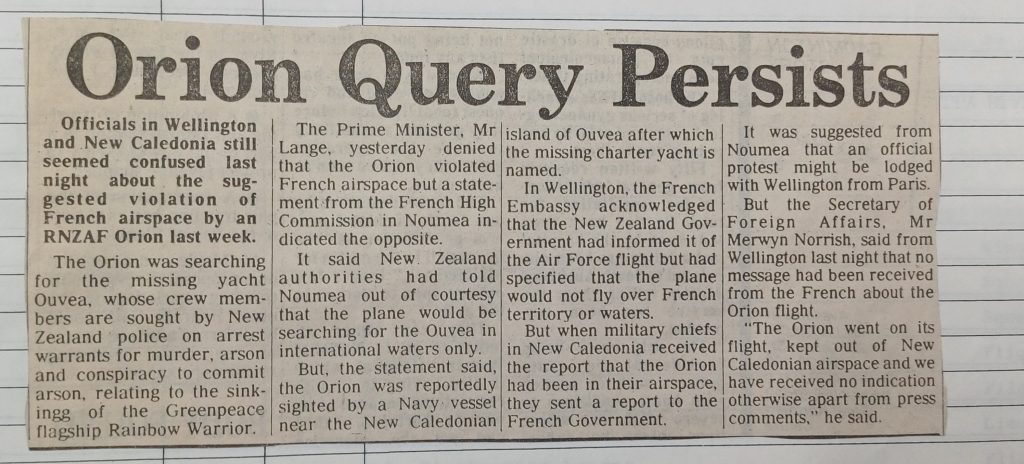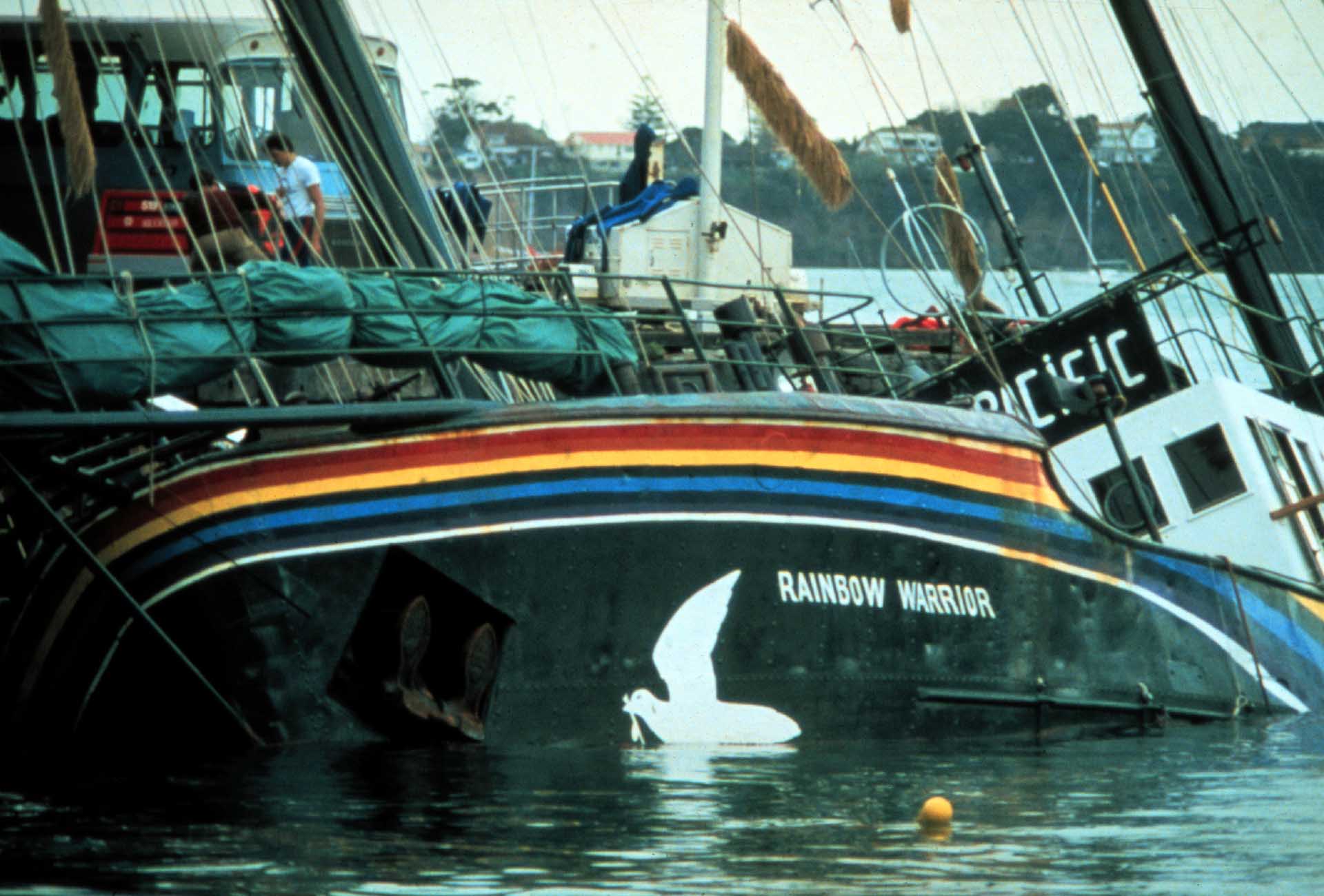Late in the evening of 10 July 1985, two explosions ripped through the Greenpeace protest ship Rainbow Warrior in Auckland Harbour, killing Portuguese photographer Fernando Pereira.
It was an unprecedented attack on New Zealand territory and sparked an international hunt for those responsible. At the centre of the investigation was a mysterious yacht called the Ouvea, which police believed had transported the explosives and the bombers into Auckland and had fled for New Caledonia.

The RNZAF was called in to help scour the Pacific for the yacht and No. 5 Squadron’s P-3K Orion NZ4203 took off from Whenuapai on 25 July to help search. Ironically the aircraft, NZ4203, soon found itself at the centre of its own international incident, as retired Flight Sergeant Don Simms recalls. Here’s Don’s story:
Back in 1985 I was a young avionics mechanic on my first posting to No. 3 Squadron at Hobsonville.
No. 5 Squadron operated the P-3 Orion at Whenuapai and would take people on patrol.
You put your name down on a list and they would contact you when your name got to the top. The deal was you would guard the aircraft at any stopovers as it was full of secret equipment.
There were always two guards that accompanied each aircraft on an overnight stopover.
In mid-July my name came up for a patrol. It was only supposed to be a fisheries day patrol with no overnight, but I didn’t mind and was looking forward to seeing how the aircraft operated.
At the morning briefing for my P-3 flight the plan suddenly changed. I was asked did I have a passport? Yes, I did.
I was told to go and get it and some overnight gear. I rushed back to Hobsonville, stopping briefly at work to explain that I may be gone for a few days, not just today!
We were going to look for the French agents that had transported the explosives used in the bombing and were known to be on a yacht sailing towards the French territory of New Caledonia.
We took off in NZ4203 and headed north at low level, searching for any yachts. None matching the one we were looking for were found.
The name of the yacht was the Ouvea. Everyone on board took turns at the large observation windows carrying out a visual watch, including me.

We had a police photographer on board who had photographed the suspected yacht as it left Norfolk Island a few days earlier.
As we approached New Caledonian airspace at low level, we made no air traffic control radio calls, we didn’t want the French to know we were there.
That was until we flew over a French Navy patrol boat! DOH! They reported us and there was a subsequent diplomatic incident which had to be dealt with by the politicians and defence hierarchy.
In the meantime, we carried on searching and when we were low on fuel we headed to Nadi in Fiji for the night. The other guard (who was a fireman from Whenuapai) and I spent a long and pretty uncomfortable night guarding the aircraft.
The aircraft was locked up, so we had to guard it from the outside! We were given a few aircraft rations to sustain us and in the middle of the night some ‘fresh’ catering was delivered by the local airport caterers. It rained most of the night but wasn’t cold fortunately as all we had on was our flying overalls. We took shelter in an overhead walkway near the P-3 which kept us mostly dry.
We took turns at trying to get some sleep. Early the next morning the P-3 crew arrived and we were sent back to the hotel to get some sleep. After a few hours of sleep, we went into town for a look around.
Late in the afternoon we headed back to the airport and the P-3 was back. They had found an empty life raft. Subsequently it was learned that the Ouvea rendezvoused with a French submarine and the agents transferred to it and scuttled the yacht. The life raft was quite likely to have been the Ouvea’s as they automatically release and inflate when submerged under water. We had been very close to catching them in the act.
It was an exciting interlude from Hobsonville and my first overseas trip since joining the RNZAF (and arguably my only ‘operational’ deployment in my nearly 18 years in uniform!). It was also my only flight in the P-3.


Police made an early breakthrough after members of the public reported seeing a man in a wetsuit dragging a zodiac ashore on Tamaki drive at 9.30pm and was picked up by a couple in a campervan.
Two days later the couple were arrested when they returned the campervan.
They were travelling on false Swiss passports and were in fact French DGSE agents Alain Marfait and Dominique Prieur. They were subsequently charged with manslaughter.
At the trial it emerged they were the support crew for the actual bombers who arrived in Auckland aboard the yacht Ouvea. The police believed four DGSE agents had smuggled the explosives into Auckland aboard the Ouvea, and then sailed for New Caledonian soon after the bombing, scuttling the yacht after being picked up by submarine.
Marfait and Prieur were found guilty of manslaughter. The New Zealand judge sentenced them each to ten years’ imprisonment on 22 November 1985.
In 1986 a deal was struck with the French Government which led to a French apology and a compensation payment. In return, the agents would serve three years on Hao Atoll in French Polynesia. They served two years before returning to France.
The suspected bombers aboard the Ouvea were never charged.
NZ4203 is now retired and in storage at the Air Force Museum of New Zealand.





